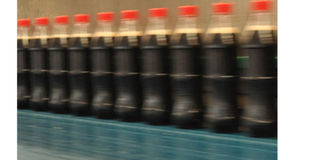Price war among soft drinks manufacturers hurts profits

Production. Bottles of manufactured soda go through a production line. The beverages industry is one of those industries where prices have dropped. FILE PHOTO
What you need to know:
The beverage industry has seen some tight competition with the entry of new players in the market.
The days of wild growth and huge profits for Uganda’s carbonated soft drink manufacturers could be over as competition pressures, which have resulted in a price war, continue to intensify.
This follows the entry of three new players; Riham, Fizzy and Azam soda manufacturers early last year, which broke the duopoly of Century Bottling Company (commonly known as Coca-Cola) and Crown Beverages (Pepsi).
Although Coca-Cola and Pepsi had underestimated the impact the new entrants (Riham, Fizzy and Azam) would have on their sales, they were later forced to discount their prices to appear cheaper than the competition so as to appeal to price sensitive consumers, a market that was getting more competitive.
For instance, the 320ml Riham plastic bottled soda products, which were cheaper and convenient (then retailing at Shs1,000,) were quickly gaining an edge over Coca-Cola and Pepsi whose cheapest 300ml returnable glass bottled products were also selling at Shs1,000.
Price cuts
Refraining from price cuts would cause sale volumes of the former duopoly to plunge even further than had been experienced, given the low per capita consumption of carbonated soft drinks in Uganda, which is estimated at only 23 bottles, compared to Tanzania’s 35 bottles and Kenya’s 40 bottles.
Coca-Cola, for instance, reduced the price of its 300ml glass bottled soda from Shs1,000 to Shs800 while the 350ml plastic-bottled Ka-Mini soda was cut from Shs1,500 to Shs1,000.
Both Coca-Cola and Pepsi cut the prices for the 500ml and one-litre plastic bottled sodas from Shs2,000 to Shs1,500 and from Shs3,000 to Shs2,500, respectively.
Not to appear as an expensive brand, Riham, which ignited the price war also later slashed the price for its 320ml soda brands from Shs1,000 to Shs800 and from Shs1,500 to Shs1,200 for the 500ml sodas.
Although price cuts are an advantage of consumers who are now paying relatively lower prices for sodas, it is a disadvantage to manufacturers as it affects their profitability, which also in turn reduces taxes to government.
Coca-Cola is said to contribute more than Shs100 billion in form of direct and indirect taxes annually while Pepsi is said to be contributing about Shs70 billion in taxes per year.
Although there are no readily available figures, consumption trends show that the former duopolies no longer sell as much as they used to before the entrance of new players.
Reasons for constrained growth
Century Bottling Company managing director Norton Kingwill, however, dismisses reports of a price war, saying price cuts witnessed in the market are a result of the sluggish growth seen in the carbonated soft drinks industry over the past few years, forcing players to lower prices to boost consumption and stimulate growth.
Mr Kingwill attributes the constrained growth in the carbonated soft drinks market over the years to slow economic recovery from the lag effects of the 2011 economic challenges, coupled with price increases for sodas.
He, however, adds that the lower contribution of carbonated soft drinks to the Non-Alcoholic-Ready-To-Drink (NARTD) category presents an opportunity for industry growth, and that soda manufacturers have invested immensely in capacity to allow them meet the expected increase in demand.
Coca-Cola invested in a $26.7 million (about Shs67.3 billion) plastic bottle production line last year that is expected to boost its production capacity and lower production costs.
All manufacturers also increased their marketing budgets mainly for print, electronic and bill boards advertising as well as building a nationwide network of distributors as they seek to grab a bigger chunk of the market.
While Mr Kingwill maintains that Coca-Cola still commands the biggest share of the market despite the entrance of new players, Mr Simon Lugoloobi, the Crown Beverages chief executive officer, says Crown Beverages has managed to bridge the gap with its biggest competitor, thus consolidating its place among the top two biggest players in the market.
However, this newspaper was unable to get a comment from Riham as the CEO, who the company said is the only authorised person to speak to the media, was reportedly in meetings.
Market players, however, note that the industry is now stronger compared to about three years ago, and is set for major growth going forward due to increased affordability and expected increase in people’s spending power.
Mr Lugoloobi explains that the market is witnessing strong growth in the plastic bottled soda sales compared to returnable glass bottle sodas, which is reflective of the consumer trends.
“Many customers today are always on the move and hungry for packaging that is convenient and in line with their mobility,” he says.
With the growing number of health-conscious consumers and other consumer trends, beverage manufacturers are struggling to stay relevant with most of them deploying several measures including adopting alternative sources of revenue through product diversification by adding lines of healthier drinks such as water and juices.
Water and juices are said to be the fastest growing segments of the beverages business and are becoming a lifeline of sorts for soda companies that have been struggling to revive tumbling soda sales.




